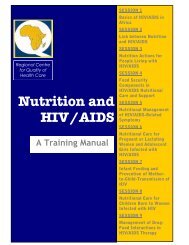2.1: Anthropometric Indicators Measurement Guide - Linkages Project
2.1: Anthropometric Indicators Measurement Guide - Linkages Project
2.1: Anthropometric Indicators Measurement Guide - Linkages Project
Create successful ePaper yourself
Turn your PDF publications into a flip-book with our unique Google optimized e-Paper software.
REFERENCES PART 9.<br />
Percentiles - A number that corresponds<br />
to one of 100 equal divisions in a range of<br />
values; a measure of relative location; a<br />
value such that at least p% of the items in<br />
the data set are less then or equal to its<br />
value and at least (100 - p)% of the items<br />
are greater than or equal to it; example:<br />
the 60th percentile means that 60% of<br />
values in the data set are less than or equal<br />
to it and (100 - 60) 40% are greater than or<br />
equal to it.<br />
Percentage of the median - A fraction or<br />
ratio based on a total of 100, where the<br />
median value of the data set equals 100; a<br />
value that equals a proportion or part of a<br />
distribution where the median represents<br />
100 percent.<br />
Population - The entire group of people<br />
that is the focus of the study (everyone in<br />
the country, or those in a particular<br />
location, or a special ethnic, economic or<br />
age group).<br />
Prevalence - The proportion of the<br />
population that has a condition of interest<br />
(i.e. wasting) at a specific point in time; a<br />
measure of a condition that is independent<br />
of the size of the population; a value that is<br />
always between 0 and 1.<br />
Protein-energy malnutrition - Undernutrition<br />
that results in an individual not<br />
receiving adequate protein or calories for<br />
normal growth, body maintenance, and the<br />
energy necessary for ordinary human<br />
activities.<br />
References or reference standards -<br />
<strong>Measurement</strong> data collected on representative,<br />
healthy populations through<br />
standardized methods; a data set that<br />
allows comparisons to be made between<br />
its values and individuals or populations<br />
being measured.<br />
Reflexive study design – One group pre-<br />
/post-test. A study in which one population<br />
group is studied on two different occasions<br />
to compare changes over time.<br />
Risk - The possibility of suffering harm;<br />
danger; “a continuous variable relating to<br />
the likelihood that a defined undesirable<br />
outcome will occur”.<br />
Sample - A part or subset of the<br />
population used to supply information<br />
about the whole population.<br />
Sample size - The number of households<br />
or persons selected to be included in a<br />
sample or survey.<br />
Sampling - The technique of selecting a<br />
representative part of the population for<br />
the purpose of determining characteristics<br />
of the whole population.<br />
9.<br />
59

















